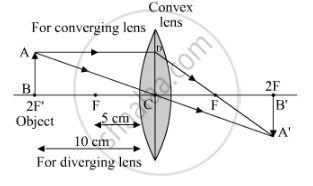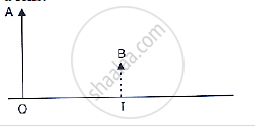Advertisements
Advertisements
Question
An object is placed 10 cm from a lens of focal length 5 cm. Draw the ray diagrams to show the formation of image if the lens is converging,
Solution
When an object is placed at 2F' of a converging lens, the image formed is real, inverted and of same size as the object. The image position at 2F is shown in the figure

APPEARS IN
RELATED QUESTIONS
A small bulb is placed at the focal point of a converging lens. When the bulb is switched on, the lens produces:
(a) a convergent beam of light
(b) a divergent beam of light
(c) a parallel beam of light
(d) a patch of coloured light
How would you alter the above diagram to show how a converging lens can produce a beam of parallel rays of light.
When an object is placed 10 cm in front of lens A, the image is real, inverted, magnified and formed at a great distance. When the same object is placed 10 cm in front of lens B, the image formed is real, inverted and same size as the object.
What is the nature of lens A?
An object is placed at a distance of 4 cm from a concave lens of focal length 12 cm. Fine the position and nature of the image.
An object is 2 m from a lens which forms an erect image one-fourth (exactly) the size of the object. Determine the focal length of the lens. What type of lens is this?
Name one of the common defects of vision and the type of lens used to remove it.
The following diagram in given below shows an object OA and its virtual image IB formed by a lens.

An object is placed on the axis of a lens. An image is formed by refraction in the lens. For all positions of the object on the axis of the lens, the positions of the image are always always between the lens and the object.State three characteristics of the image.
Distinguish between concave and convex lens.
A lens forms an image between the object and the lens. Name the lens.
